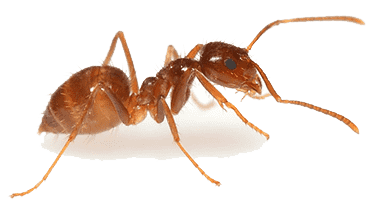
Crazy Ants
Scientific Name: Nylanderia fulva
Crazy ants get their name from the fact that they often look frantic and erratic in their movement, like they are lost, instead of following a defined trail. Crazy ants’ legs are extremely long and give it a very distinct appearance.
Lifespan: 76-84 days
Description
Crazy ants are reddish brown in color and are relatively small measuriing approximately 1/8 inch in length. The body has scattered long, coarse hairs. Both the male and the female have wings but the males only rarely used them to fly.
The end of the abdomen has an acidopore, which is a small round terminal orifice for venom and is surrounded by a ring of hairs. Crazy ants do not sting but they can bite. They are known to curve their bodies to deliver venom from their acidopore.
Colonies
Colonies of the Crazy ant are moderate to large in size and may contain several queens. On warm, humid evenings males congregate around nest entrances looking for mates. Mating occurs in these gatherings around nest entrances. After mating, the queen will lay her eggs in a nest after which the worker ants care for and feed the larvae.
Where do Crazy Ants Live?
Crazy ants are highly versatile, living in both moist and dry habitats. They cannot survive extremely cold climates and may infest houses and buildings when weather changes.
The Crazy ant is not native to the U.S. but thought to have been introduced from Africa or Asia. In the U.S., the Crazy ant is common throughout the north, northeast, and south as well as California, Arizona, and Hawaii. The Crazy ant has also been reported in Missouri and Canada.
What do Crazy Ants Eat?
The Crazy ant’s diet consists mainly of the honeydew of aphids, and will even care for young aphids in order to harvest their honeydew. Other insects like mealybugs, whiteflies, and planthoppers are favorite sources of honeydew for the Crazy ant.
The Crazy ant will also feed on anything sweet, including food items in your kitchen. It may also eat living or dead insects. The Crazy ant is a predator, scavenger, and forager and will search for food night and day. During summer months the Crazy ant may prefer high-protein diets and refuse a sugar bait.
Known to travel considerable distances to forage for food sources, the Crazy ant may nest away from foraging sites. Trash, holes in trees and plants, rotten wood, soil, are a perfect envorment top attract crazy ants. A Crazy ant nest is easily identifiable by the worker ant carrying food back to its nest.
Trails
Little black worker ants forage in scent-marked trails, which can be seen along sidewalks and foundation walls. If a colony moves inside a building, large populations can invade cracks and crevices, establishing highly visible foraging trails, particularly along counters, cabinets and pantries.
How to Get Rid of Crazy Ants
Like most ants, Crazy Ants are on the lookout for food and water. Keeping conditions sanitary in the kitchen and eating areas is the best prevention for not getting any kind of ant. Make sure trash containers are tightly sealed and any spilled food or drink are immediately cleaned up with soap and water. For the do-it-yourselfer, try Maxforce FC Ant Bait Gel. For professional and guaranteed ant removal call Jarrod’s Pest Control.
REQUEST A QUOTE

100% Satisfaction
There is a reason our work is guaranteed…we do it right. If you would ever have a problem with pests while we are in charge of your pest control, we will work until the problem is resolved. Our contracts provide you with quarterly service and we will take care of any problems that may happen to arise between visits.
We Guarantee It!

Request Free Pest Inspection
EMERGENCY SERVICE AVAIALBLE
Request Free Pest Inspection
EMERGENCY SERVICE AVAIALBLE


